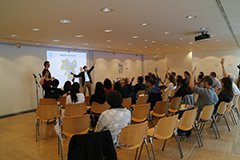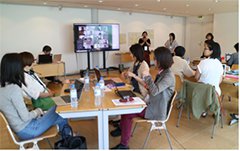New Discoveries, New Challenges
The Japan Cultural Institute in Paris
KONDO Yumiko, MITSUYA Mayumi
Numerous Japanese-language programs are run by the Japan Cultural Institute in Paris (hereinafter “the Institute”), but in this report, I will write about two new experimental programs that were carried out based on our existing programs. (Please also refer to previous reports.)
1. Japanese-Language Course on the Kansai Dialect–Japanese? Nice. The Kansai Dialect? Awesome!

Students raise their hands in response to
the question, “Who here has been to Osaka?”
There is an organization for the cultural centers of various countries in Paris called the “Forum des Instituts Culturels Etrangers à Paris” or “Forum of Foreign Cultural Institutes in Paris” (FICEP: https://www.ficep.info/) that carries out a yearly cultural event called “Semaine des cultures étrangères” (Foreign Culture Week). The Institute’s Japanese-language course participates in the event almost every year, and in 2019, we invited a teacher from the Japan Foundation Japanese-Language Institute, Kansai, who is a native speaker of the Kansai dialect to hold a course called “Japanese-Language Course on the Kansai Dialect–Japanese? Nice. The Kansai dialect? Awesome!” This Japanese-language course in part used the Kansai dialect course on the Japanese-language learning platform “JF Japanese e-learning Minato” (https://minato-jf.jp/) developed by the Japan Foundation to introduce simple expressions in the Kansai dialect and greetings that travelers can use. I was worried whether the French would take an interest in a specific region and dialect, but many people gathered on the day of the class including people who had traveled to Japan, people who liked Kansai, people who liked Japan or the Japanese language, and people with no experience studying Japanese but had an interest in doing so.
The course balanced linguistic and cultural elements so that those without experience studying the Japanese language could enjoy it as well. For example, we had the students practicing standard Japanese before teaching them the same expressions in the Kansai dialect, and included cultural quizzes that can be enjoyed without the Japanese language. Meanwhile, the teacher showed their true form as a native speaker of the Kansai dialect by taking care to throw in a few laughs during their talk. There is a famous cliche of Kansai comedy that say “There’s a phone call for you” and hand someone a banana, which they invariably put to their ear and say “Hello?” During the class, however, the teacher used a small baguette instead of a banana as a nod to the French participants. These and other jokes resulted in a lively course filled with laughter from start to finish that was a big hit with the participants.
For me, it was a new discovery to see the French participants, normally very conscious about sticking to norms, show an interest in Japan’s regional culture and dialect. While I normally spend my time teaching Japanese language to students attending the Japanese-language course at the Institute, the Kansai dialect course reminded me of the importance of sometimes communicating about the appeals of the Japanese language and culture from a different perspective.
2. Creating Participatory Japanese-Language Teacher Training Together–Connecting Online and Offline

A hybrid training session combining face
to face and online participation.
Every summer, the Institute plans and hosts the gathering of the Japanese-Language Education Network in Europe which attracts people involved in Japanese-language education from throughout the region. (See the reports from 2009 and 2018.)
The gathering incorporates hot topics from the world of education and Japanese-language education in particular every year, but in AY2019, we tried two new experiments for the training. The first was that in addition to participants at the Institute, which served as the venue, we also called for online participants, and we connected the two. Furthermore, we arranged separate activities for the offline and online groups, and even organized exchange for the two groups, rather than simply having the online participants watch what was happening in the venue. *1 In other words, we created a hybrid form of training in which the real and online training venues each proceeded in parallel.
(*1: We also experimented with hybrid training for the event in AY2018, but we did not publicly call for online participants.)
The design of the training is very important to realize such an event, but a great deal of cooperation is also necessary, as a variety of additional work is incurred, including facilitation and technical support. Accordingly, this time we tried having the participants get involved in the management of the training as well, and had them take on a variety of roles. In this way, the training was participatory in that the participants got involved in the operations. Since the participants must carry out their roles while also learning, a great number of additional tasks need to be handled. While some participant feedback was less positive, such as that they were unable to concentrate on the training while they were handling an assigned task, or that they were worn out, other feedback was positive, such as that they were able to kill two birds with one stone by studying the training theme, “Instructional Design,” while also learning how to manage online training. The result of our approximately three months of repeated preparations was a new approach to teacher training. While there is great room for further improvement, I am glad that we did it.
This Japanese-language teacher training has been going on for more than a decade. It is highly creative work that can be carried out through cooperation with the many people involved, and we can constantly flexibly adapt to the needs and situation of the times and take on new challenges. Perhaps this is one of the appealing aspects of my job.
- What We Do Top
- Arts and Cultural Exchange [Culture]
- Japanese-Language Education Overseas [Language]
- Japanese-Language Education Overseas [Language] Top
- Learn Japanese-language
- Teach Japanese-language
- Take Japanese-Language Test
- Know about Japanese-language education abroad
- The Japanese-Language Institute, Urawa
- The Japanese-Language Institute, Kansai
- Japanese-Language Programs for Foreign Specified Skilled Worker Candidates
- Japanese Language Education for Japanese Children Resident Overseas and for the Descendants of Migrants
- Archives
- Japanese Studies and Global Partnerships [Dialogue]
- JF digital collection
- Other Programs / Programs to Commemorate Exchange Year
- Awards and Prizes
- Publications
